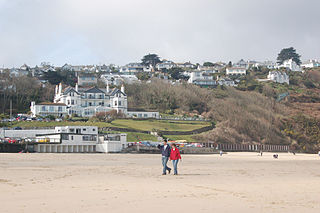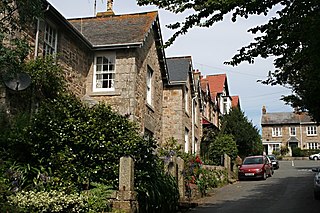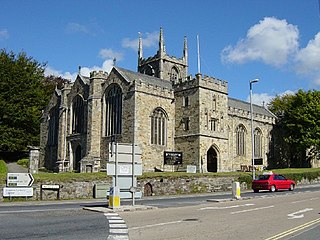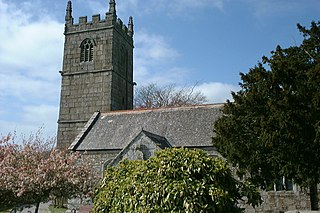
The Cathedral of the Blessed Virgin Mary is a Church of England cathedral in the city of Truro, Cornwall. It was built between 1880 and 1910 to a Gothic Revival design by John Loughborough Pearson on the site of the parish church of St Mary. It is one of only three cathedrals in the United Kingdom featuring three spires.

Carbis Bay is a seaside resort and village in Cornwall, England. It lies 1 mile (1.6 km) southeast of St Ives, on the western coast of St Ives Bay, on the Atlantic coast. The South West Coast Path passes above the beach.

St Bartholomew's Church is a parish church of the Church of England Diocese of Truro in Lostwithiel, Cornwall, England, United Kingdom.

Madron is a civil parish and village in west Cornwall, England, United Kingdom. Madron is named after Saint Madern's Church. Its annual Trafalgar Service commemorating the death of Vice Admiral Horatio Nelson was started on 27 October 1946, following a local tradition that his death was first announced on British soil in the Union Hotel, Penzance.

Trengwainton is a garden situated in Madron, near Penzance, Cornwall, England, UK, which has been in the ownership of the National Trust since 1961. The garden is noted for its collection of exotic trees and shrubs and offers views over Mount's Bay and The Lizard. The house is not open to the public.

Gulval is a village in Cornwall, England, United Kingdom. Although historically a parish in its own right, Gulval was incorporated into the parishes of Ludgvan, Madron and Penzance in 1934, and is now considered to be a suburb of Penzance. Gulval still maintains its status as an ecclesiastical parish and parts of the village church date back to the 12th-century. Together with Heamoor, Gulval still retains its status as an electoral ward. The ward population at the 2011 census was 4,185.

The Church of St Buryan is a late-15th-century Church of England parish church in St Buryan in Cornwall, England.

St Nicholas's Church, Tresco, is a parish church in the Church of England located in Tresco, Isles of Scilly, UK.

St Mary's Church, St Mary's is a parish church in the Church of England located in Hugh Town, St Mary's, Isles of Scilly, UK. The Church was consecrated on 7 September 1838 and replaced the church at Old Town which was inconvenient for the Hugh Town population and in need of repair.

St Bridget's Church, Morvah is a parish church in the Church of England Diocese of Truro located in Morvah, Cornwall, UK. It was licensed for divine service by the Bishop of Exeter on 22 September 1400. The tower is the only remaining medieval part of the church. The nave and chancel were rebuilt in 1828. The church was added to the National Heritage List for England in 1954 at grade II, the lowest of three grades for listed buildings.

St Uny Church, Lelant, is the Church of England parish church of Lelant, Cornwall, England. It is dedicated to Saint Uny who is also the patron saint of Redruth. It is a Grade I listed building.

St Petroc's Church, Bodmin, also known as Bodmin Parish Church is an Anglican parish church in the town of Bodmin, Cornwall, England, United Kingdom.

St Mary's Church, Penzance is a Grade II* listed parish church in the Church of England in Penzance, Cornwall.

St Paul's Church, Truro is a Grade II listed former parish church in the Church of England Diocese of Truro and in Truro, Cornwall.

St Erth’s Church, St Erth, is a Grade I listed parish church in the Church of England Diocese of Truro in St Erth, Cornwall, England, UK.

St Gwinear's Church, Gwinear is a Grade I listed church in the Church of England in Gwinear, Cornwall.
Thomas Robins Bolitho (1840–1925) was a Cornish banker and landowner who served as High Sheriff of Cornwall in 1890.

St Martin and St Meriadoc's Church, Camborne is a Grade I listed parish church in the Church of England in Camborne, Cornwall.

All Saints’ Church, Tuckingmill is a Grade II listed parish church in the Church of England in Pendarves Street, Tuckingmill, Camborne, Cornwall.
Sir Rose Price, 1st Baronet was a British planter and landowner who owned sugar plantations in the colony of Jamaica.






















